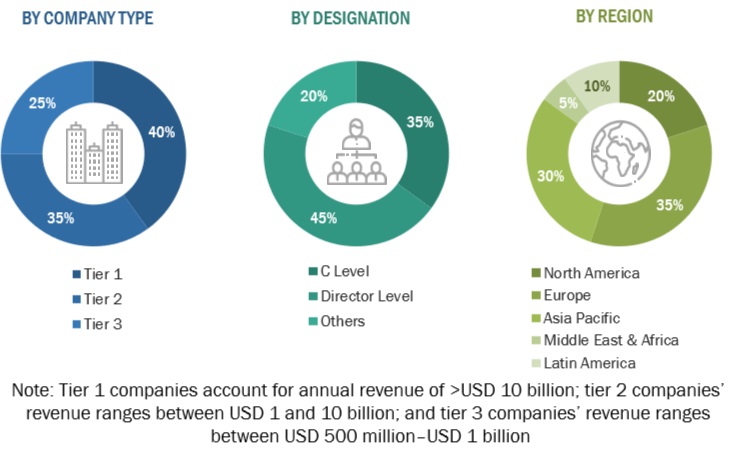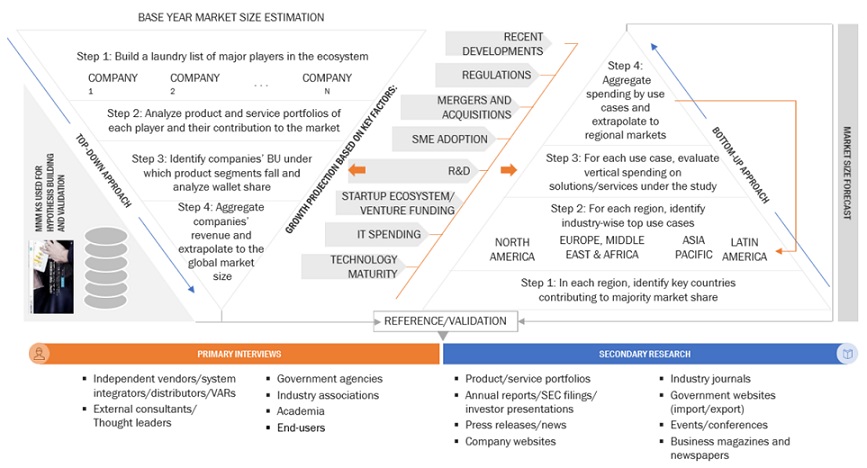The translation management systems market research study involved extensive secondary sources, directories, journals, and paid databases. Primary sources were mainly industry experts from the core and related industries, preferred translation management systems providers, third-party service providers, consulting service providers, end users, and other commercial enterprises. In-depth interviews were conducted with various primary respondents, including key industry participants and subject matter experts, to obtain and verify critical qualitative and quantitative information, and assess the market’s prospects.
Secondary Research
In the secondary research process, various sources were referred to, for identifying and collecting information for this study. Secondary sources included annual reports, press releases, and investor presentations of companies; white papers, journals, and certified publications; and articles from recognized authors, directories, and databases. The data was also collected from other secondary sources, such as journals, government websites, blogs, and vendors websites. Additionally, translation management systems spending of various countries was extracted from the respective sources. Secondary research was mainly used to obtain key information related to the industry’s value chain and supply chain to identify key players based on solutions, services, market classification, and segmentation according to offerings of major players, industry trends related to software, hardware, services, technology, applications, warehouse sizes, verticals, and regions, and key developments from both market- and technology-oriented perspectives.
Primary Research
In the primary research process, various primary sources from both supply and demand sides were interviewed to obtain qualitative and quantitative information on the market. The primary sources from the supply side included various industry experts, including Chief Experience Officers (CXOs); Vice Presidents (VPs); directors from business development, marketing, and translation management systems expertise; related key executives from translation management systems solution vendors, SIs, professional service providers, and industry associations; and key opinion leaders.
Primary interviews were conducted to gather insights, such as market statistics, revenue data collected from solutions and services, market breakups, market size estimations, market forecasts, and data triangulation. Primary research also helped in understanding various trends related to technologies, applications, deployments, and regions. Stakeholders from the demand side, such as Chief Information Officers (CIOs), Chief Technology Officers (CTOs), Chief Strategy Officers (CSOs), and end users using translation management systems solutions, were interviewed to understand the buyer’s perspective on suppliers, products, service providers, and their current usage of translation management systems solutions and services, which would impact the overall translation management systems market.

To know about the assumptions considered for the study, download the pdf brochure
|
COMPANY NAME
|
DESIGNATION
|
|
Lingo24
|
Language Technology, Localization Content Lifecycle & Translation Workflow Consultant |
|
RWS Group
|
Director, Linguistic AI Consultant |
|
Localization Lab
|
Translation and Localization Professional |
|
BingX
|
Language Localization Specialist & Language Owner |
|
Unbabel
|
Language Operations Specialist |
|
Commit Global
|
Localization Project Manager |
|
Pegasystems
|
Senior Localization Specialist, Product UI |
|
Centific
|
Director of Strategy & Research |
|
AWS
|
Senior Consultant AI & ML |
|
Expert AI
|
Senior Project Manager |
|
Senseforth AI
|
Senior Software Developer- AI |
Market Size Estimation
In the bottom-up approach, the adoption rate of translation management systems solutions and services among different end users in key countries with respect to their regions contributing the most to the market share was identified. For cross-validation, the adoption of translation management systems solutions and services among industries, along with different use cases with respect to their regions, was identified and extrapolated. Weightage was given to use cases identified in different regions for the market size calculation.
Based on the market numbers, the regional split was determined by primary and secondary sources. The procedure included the analysis of the translation management systems market’s regional penetration. Based on secondary research, the regional spending on Information and Communications Technology (ICT), socio-economic analysis of each country, strategic vendor analysis of major translation management systems providers, and organic and inorganic business development activities of regional and global players were estimated. With the data triangulation procedure and data validation through primary interviews, the exact values of the overall translation management systems market size and segments’ size were determined and confirmed using the study.
Global Translation management systems Market Size: Bottom-Up and Top-Down Approach:

To know about the assumptions considered for the study, Request for Free Sample Report
Data Triangulation
Based on the market numbers, the regional split was determined by primary and secondary sources. The procedure included the analysis of the translation management systems market’s regional penetration. Based on secondary research, the regional spending on Information and Communications Technology (ICT), socio-economic analysis of each country, strategic vendor analysis of major translation management systems providers, and organic and inorganic business development activities of regional and global players were estimated. With the data triangulation procedure and data validation through primaries, the exact values of the overall Translation management systems market size and segments’ size were determined and confirmed using the study.
Market Definition
According to RWS, a translation management system is software for automating human language translation efforts. A TMS’s purpose is to optimize the translation processes in an organization by creating automated workflows for translating repeatable and already previously translated content, freeing time for translators who can now focus on fine-tuning translated content or on translating content that is more nuanced and needs a human touch for a perfect end-result. A TMS centralizes all translation efforts, offering enterprises a single solution for managing all content translation and localization efforts. A TMS comprises tools like translation memory, vocabulary management, collaboration tools, a quality assurance module, or a content translation dashboard for estimating costs. From an integration perspective, most TMSs are based on open standards-based architectures that enable seamless integration with other software from the enterprise suite. Digital asset management (DAM), software configuration management (SCM), databases, and file systems are some content repositories that TMSs integrate, source from, or deliver content to.
Stakeholders
-
Application design and software developers
-
Translation management systems software vendors
-
Business analysts
-
Cloud service providers
-
Consulting service providers
-
Enterprise end-users
-
Distributors and Value-added Resellers (VARs)
-
Government agencies
-
Independent Software Vendors (ISV)
-
Managed service providers
-
Market research and consulting firms
-
Support and maintenance service providers
-
System Integrators (SIs)/migration service providers
-
Language service providers
-
Technology providers
Report Objectives
-
To define, describe, and predict the translation management systems market by offering (software and services), application, content type, business function, vertical, and region
-
To provide detailed information related to major factors (drivers, restraints, opportunities, and industry-specific challenges) influencing the market growth
-
To analyze the micro markets with respect to individual growth trends, prospects, and their contribution to the total market
-
To analyze the opportunities in the market for stakeholders by identifying the high-growth segments of the market
-
To analyze opportunities in the market and provide details of the competitive landscape for stakeholders and market leaders
-
To forecast the market size of segments for five main regions: North America, Europe, Asia Pacific, Middle East Africa, and Latin America
-
To profile key players and comprehensively analyze their market rankings and core competencies.
-
To analyze competitive developments, such as partnerships, new product launches, and mergers and acquisitions, in the market
-
To analyze the impact of recession across all the regions across the translation management systems market
Available Customizations
With the given market data, MarketsandMarkets offers customizations as per your company’s specific needs. The following customization options are available for the report:
Product Analysis
-
Product quadrant, which gives a detailed comparison of the product portfolio of each company.
Geographic Analysis
-
Further breakup of the North American translation management systems market
-
Further breakup of the European market
-
Further breakup of the Asia Pacific market
-
Further breakup of the Middle Eastern & African market
-
Further breakup of the Latin America market
Company Information
-
Detailed analysis and profiling of additional market players (up to five)



Growth opportunities and latent adjacency in Translation Management Systems Market